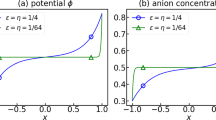Abstract
Thallous ion in gramicidin channels displays the anomalous molefraction effect and other behavior that suggests its permeationmechanism might be more complicated than the mechanisms for sodiumor potassium ion permeation. The permeation is modeled by eithermultistate first order kinetics where the number of states and therate constants are modified to fit the data or an ion displacementmechanism that requires higher order rate terms. Although the twoclasses of mechanism are difficult to distinguish usingcurrent-voltage data, the two classes give different responses toa modulated transmembrane potential with frequency comparable tothe rate constants for intrachannel ion transitions. Themultistate first order kinetics give currents only at themodulation frequency. Information is transmitted in the phase andamplitude of the observed current. The non-linear iondisplacement mechanism produces harmonic frequencies. A detailedspectral analysis then distinguishes the two classes of mechanismand provides a range of frequency and phase data that permitsdetermination of the appropriate rate constants.
Similar content being viewed by others
References
Andersen, O.S.: Ion movement through gramicidin a channels: Single channel measurements at very high potentials, Biophys. J. 91(1983), 119–133.
Neher, E.: Ionic specificity of the gramicidin channel and the thallous ion, Biochim. Biophys. Acta 401(1975) 540–544.
Glauber, R.: Time dependent statistics of the Ising model, J. Math. Phys 4(1963), 294–307.
Starzak, M.: A model for conductance changes in squid giant axon, I: Interactive relaxation, J. Theor. Biol. 39(1973), 487–504.
Bretag, H., Davis, B.R. and Kerr, D.I.B.: Potassium conductance models related to an interactive subunit membrane, J. Membr. Biol. 16(1974), 363–379.
Cole, K.S. and Moore, J.W.: Potassium ion current in the squid giant axon: Dynamic characteristic, Biophys. J. 1(1960), 1–14.
Starzak, M.: Gating molecule interactions in K+ channels: A consistent explanation for Cole Moore shifts and potential ramp experiments, J. Biol. Phys. 10(1982), 1–16.
Hodgkin, A.L. and Huxley, A.F.: A quantitative description of membrane current and capacity by means of a varying potential control voltage clamp, J. Physiol. Lond. 17(1952), 500–544.
Hill, T. and Chen, Y.: On the theory of ion transport across the nerve membrane, II: Potassium ion kinetics and cooperativity, Proc. Nat. Acad. Sci. 68(1971), 1711–1715.
Author information
Authors and Affiliations
Rights and permissions
About this article
Cite this article
Starzak, M.E. Resolving Linear and Non-Linear Interactive Kinetic Mechanisms for Ions in Membrane Channels. Journal of Biological Physics 23, 133–142 (1997). https://doi.org/10.1023/A:1004932703737
Issue Date:
DOI: https://doi.org/10.1023/A:1004932703737




